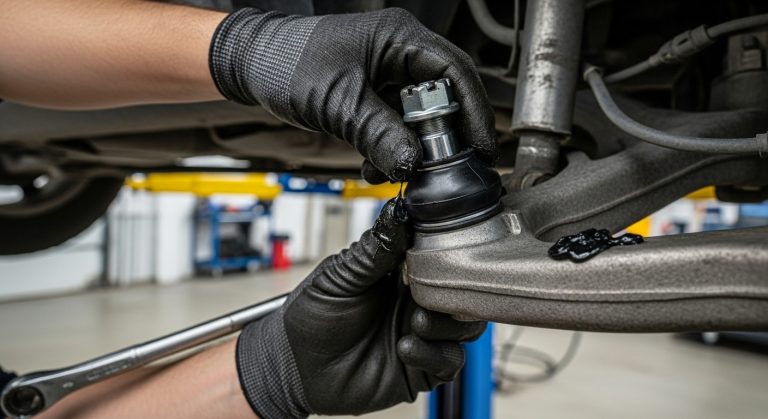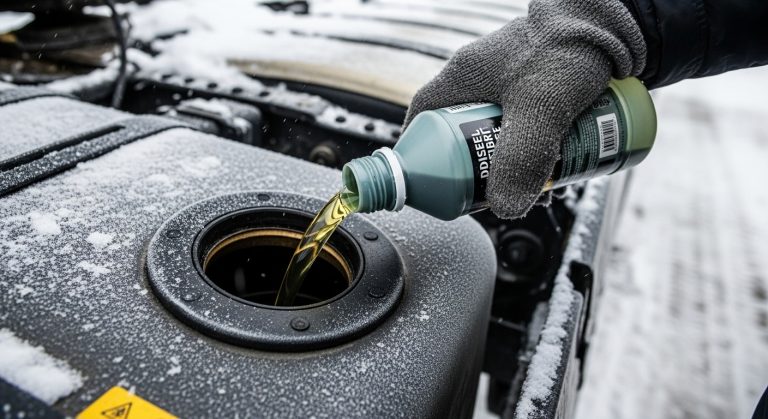Your oil temperature is low because factors like a stuck-open thermostat, cold ambient conditions, or oil contamination are preventing the oil from reaching the proper heat range.
Sensor faults or blockages in the oil cooler can also give inaccurate low readings.
Low oil temperature increases oil viscosity, reducing lubrication efficiency and potentially harming engine components.
Understanding these causes and their impact can help you identify and address why your oil temp isn’t rising as it should.
Key Takeaways
- A stuck-open thermostat causes excessive coolant flow, preventing oil from reaching proper operating temperature.
- Cold ambient temperatures and short drives delay oil warm-up, resulting in consistently low oil temperature readings.
- Contaminants like water or fuel dilution lower oil viscosity, affecting heat transfer and causing lower oil temperature.
- Faulty oil temperature sensors or wiring issues can produce inaccurate low oil temperature readings.
- Mechanical problems such as weak oil pumps or blocked oil coolers impair oil circulation and heat distribution.
Causes Related to Oil Viscosity and Contamination
When you notice a low oil temperature, one key factor to investigate is how contamination and viscosity changes affect the oil’s performance. Contaminants like natural gas, solvents, or fuel dilution reduce oil viscosity by diluting the base oil, leading to thinner oil films and impaired heat transfer.
Dilution and contamination can occur when reservoirs are topped off with incorrect lubricants, further exacerbating viscosity loss. Proper maintenance and the use of high-quality lubricants can help mitigate these issues.
Water contamination accelerates chemical breakdown in synthetic esters, sharply decreasing viscosity. Thermal and chemical degradation further degrade oil molecules, lowering viscosity permanently and compromising lubrication.
Oils with low viscosity index (VI) suffer more pronounced viscosity loss at varying temperatures, especially if contaminated or improperly blended. Cold ambient conditions increase oil stiffness, restricting flow and delaying temperature rise, which may mask actual viscosity issues.
Monitoring contamination sources and selecting appropriate high VI lubricants are essential for maintaining stable oil viscosity and preventing low oil temperature anomalies.
Influence of the Thermostat and Cooling System on Oil Temperature
Although you might focus on oil properties to diagnose low oil temperature, the thermostat and cooling system play a crucial role in regulating engine and oil heat. The thermostat controls coolant flow, maintaining engine temperature within 195–220°F. Positioned between the engine and radiator, the thermostat regulates coolant flow to prevent overheating or underheating.
If it sticks open, coolant circulates excessively, preventing the engine and oil from reaching ideal temperature, causing low oil temp. Conversely, a stuck-closed thermostat leads to overheating, not low oil temp. Synthetic oils like Pennzoil Platinum and Mobil 1 are designed to maintain optimal lubrication even under fluctuating temperatures, which can help mitigate effects of inconsistent oil heating.
Other cooling components—radiator, water pump, fans, and sensors—also influence oil temperature by managing coolant circulation and heat dissipation. Faulty thermostat operation or cooling system blockages disrupt consistent engine warm-up, resulting in prolonged low oil temperature.
This reduces oil lubrication efficiency and increases viscosity, potentially harming engine performance. Monitoring oil temperature can therefore indicate thermostat and cooling system health.
Impact of Driving Conditions and Ambient Temperature

Because ambient temperature and driving conditions directly influence engine heat generation and oil viscosity, they play a crucial role in determining oil temperature. Cold ambient temps thicken oil, delaying warm-up and lowering oil temp readings, especially during short or low-load drives.
Additionally, engine oil lubricates moving parts to reduce wear, so maintaining proper oil temperature is essential for engine protection. Trucks and cars may experience different oil temperature dynamics due to their engine load and usage patterns.
Conversely, hot ambient conditions thin oil but may still show low oil temps if driving doesn’t sufficiently stress the engine.
| Driving Condition | Ambient Temperature Effect | Oil Temperature Result |
|---|---|---|
| Short city trips | Cold thickens oil | Lower oil temp, slow warm-up |
| Extended highway drive | Warm thins oil | Stable, ideal oil temp |
| Stop-and-go traffic | Cooler temps slow heating | Persistently low oil temp |
| Heavy-load driving | Hot ambient accelerates heating | Elevated oil temperature |
Monitoring these factors helps diagnose persistent low oil temperature readings.
Mechanical and Sensor-Related Factors Affecting Oil Temperature
If your oil temperature reads lower than expected despite appropriate driving conditions, mechanical issues or sensor faults might be the cause. Check the oil cooler for blockages or malfunction, as restricted flow can produce misleading low readings. A stuck-open thermostat can overcool the oil by allowing excessive coolant flow.
Weak oil pumps reduce circulation, impairing uniform oil heating. Engine combustion inefficiencies also limit heat generation, affecting oil temperature. Sensor faults are common culprits: damaged oil temperature sensors, poor wiring connections, or incorrect calibration can all produce inaccurate low readings.
Additionally, sensor placement in cooler oil regions or electrical interference may distort measurements. To avoid engine damage, it is crucial to maintain the oil filter properly, as it ensures clean oil circulation and reduces component wear.
Addressing these mechanical and sensor-related factors is vital to correctly diagnose abnormal oil temperature and guarantee reliable engine monitoring. Low oil temperatures can cause inadequate lubrication, increasing friction and accelerating engine wear, so prompt diagnosis is essential.
Consequences of Low Oil Temperature on Engine Performance and Longevity

When your oil temperature remains low, the oil’s viscosity increases markedly, causing it to thicken and flow less efficiently through the engine. This thicker oil delays the formation of a full lubricating film, increasing metal-to-metal contact and friction.
Maintaining calibrated oil temperature is crucial for performance and engine health to avoid these issues. In mechanical systems, proper lubrication is essential to reduce noise and vibration, which can be exacerbated by inadequate oil temperature.
Low oil temperature thickens oil, reducing flow and increasing friction by delaying full lubrication.
As a result, critical components like bearings, camshafts, and pistons experience accelerated wear and stress. Low oil temperature also prolongs engine warm-up time, reducing fuel efficiency and power output due to increased internal friction.
Additionally, sluggish oil circulation during cold starts raises mechanical resistance and starter motor strain, heightening the risk of early engine damage. Over time, repeated operation at low oil temperatures accelerates component degradation, compromises engine smoothness, and increases the likelihood of mechanical failures.
Ultimately, this shortens engine longevity and impairs overall performance by preventing oil from operating within its optimal temperature range.
Frequently Asked Questions
How Does Oil Temperature Affect Fuel Efficiency?
Oil temperature directly impacts fuel efficiency by influencing oil viscosity and engine friction. When oil is cold, it thickens, increasing internal resistance and fuel consumption during warm-up.
As oil heats to its suitable range, viscosity drops, reducing friction and improving combustion efficiency.
Conversely, excessively high oil temperatures degrade oil quality, risking engine wear and decreased efficiency.
Maintaining oil within the ideal temperature range ensures proper lubrication, minimizing fuel use and engine strain.
Can Using Synthetic Oil Influence Oil Temperature Readings?
You know the saying, “Don’t judge a book by its cover”—the same applies to oil temperature readings.
When you use synthetic oil, its uniform molecular structure and stable viscosity mean it flows better, especially at low temps.
This improved flow can cause your oil temp sensor to show slightly lower or more stable readings, not because your engine’s colder, but due to how synthetic oil absorbs and dissipates heat differently than conventional oil.
What Role Do Oil Additives Play in Maintaining Oil Temperature?
You rely on oil additives to stabilize and regulate oil temperature effectively. They improve thermal stability, preventing excessive heat spikes and ensuring consistent viscosity despite temperature changes.
Friction-reducing and anti-wear additives minimize heat generation, while seal-protecting agents maintain proper oil flow. Additionally, additives enhance heat transfer, promoting efficient cooling.
Together, these components ensure your oil stays within an ideal temperature range, preserving engine performance and preventing damage.
How Often Should Oil Temperature Sensors Be Calibrated or Replaced?
When it comes to oil temperature sensors, you shouldn’t wait for the cows to come home—calibrate them regularly. Typically, you’ll want to schedule annual calibrations.
But if you operate in harsh or corrosive environments, tighten that to every six months.
Replace sensors showing persistent drift or calibration failures. Following manufacturer guidelines and monitoring sensor performance helps you decide when recalibration or replacement is needed to maintain precise and reliable measurements.
Is It Safe to Drive Long Distances With Consistently Low Oil Temperature?
You shouldn’t drive long distances with consistently low oil temperature. Cold oil thickens, reducing lubrication and increasing engine wear, risking damage or failure.
Low oil temperature impairs heat dissipation and engine efficiency, causing higher fuel consumption and mechanical stress. Address thermostat or oil cooler faults before extended trips.
Use synthetic oil and guarantee proper engine warm-up to maintain ideal oil temperature around 90°C–110°C, safeguarding your engine’s performance and longevity.
Keep Your Engine Flowing, Not Freezing
If your oil temperature stays low, picture your engine running like a sluggish river in winter—thick, slow, and strained. This often signals issues with oil viscosity, a stuck thermostat, or sensor glitches.
Ignoring it can starve your engine of proper lubrication, causing wear and reduced efficiency. By diagnosing these factors promptly, you guarantee your engine flows smoothly, maintaining peak performance and longevity under all conditions.
Don’t let low oil temp freeze your engine’s potential.




